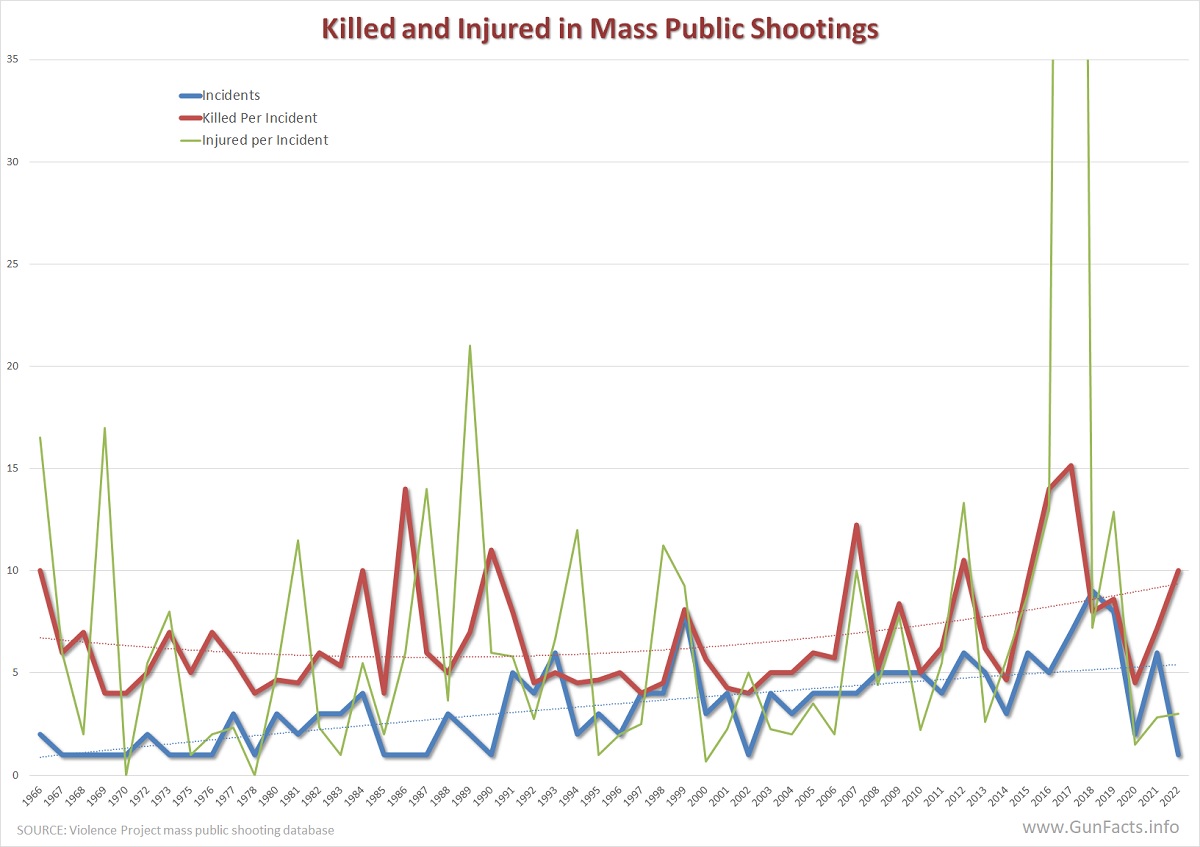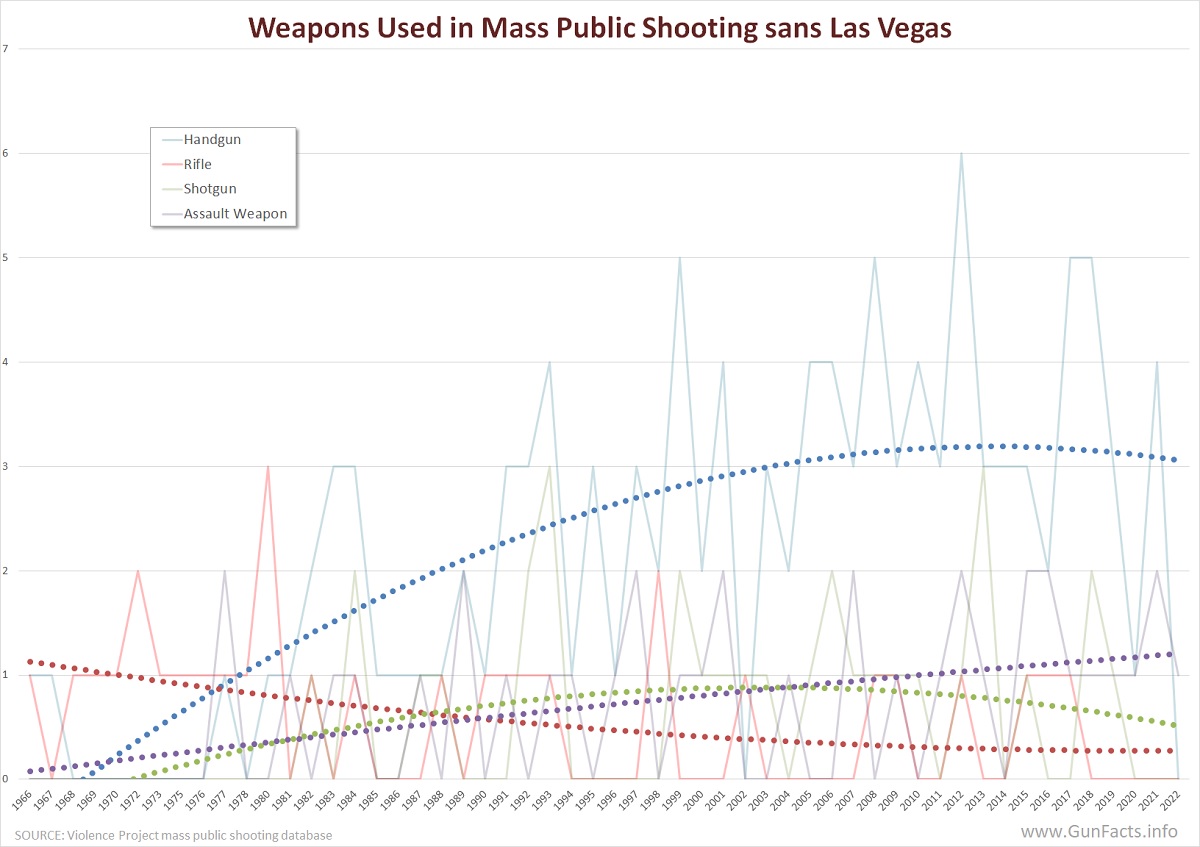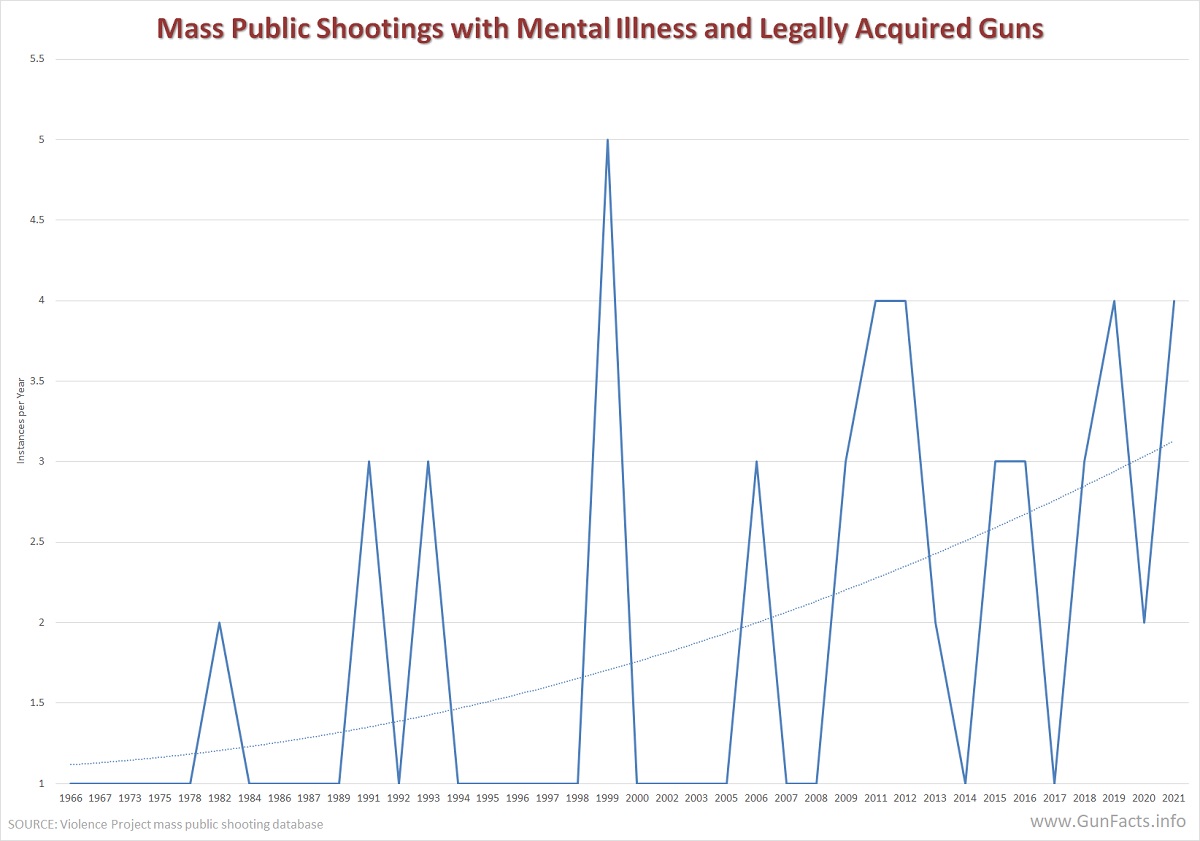Trends in Mass Public Shootings
The largest multilingual international database of mass public shootings (MPS) tells us that they are increasing globally, less rapidly in the United States, but the average number of deaths in American MPSs is rising faster than the world at large.
Let us then look at some of the factors that may contribute to mass shootings and see if there are rising rates of underlying causes.
Main Take-aways
- 41% of mass public shooters with mental health issues got their guns legally, and the rate is rising.
- MPSs are on the rise, but not steeply.
- Handguns are outpacing all other weapon types, including “assault weapons.”
- Higher capacity magazines are radically increasing in use.
- The rate of legally acquired guns is rising much faster than illegally obtained guns.
Precautions and Notes
Repeat after me… mass public shootings are statistically rare events, and as such, trends and isolating causes are of a fragile nature. Now keep repeating that, because reading too much into the following data opens you to incorrect beliefs. That being said, the data will illustrate areas of concern.
For most of the data, we relied on the Violence Project’s MPS database, which is the most complete with data going back to 1966, and unprecedented access to background and medical information about the shooters. But it lacks a couple of important data elements – namely, granularity on magazine capacities used in MPSs, and “cattle pen scenarios,” a concern identified by the Gun Facts project.
Incidents, Deaths and Injuries
 |
 |
 |
 |
 |
 |
 |
The number of incidents a year, and the number of people killed is indeed rising. Not steeply, but steadily, even when we compensate for unusual elements.
By unusual, I mean 2017 and 2018, two years where we saw seven and eight MPSs respectively, when the average for the twenty-first century is four per year. Also, there were multiple high fatality “competition killings,” such as Parkland Highschool (17 dead), Sutherland Springs (25) and the mother of all MPS, Las Vegas (58).
Yet, when we compensate just a bit by removing the ghastly Las Vegas tragedy, we still see upward trends. Not as steep, but still rising.
Given what we know or believe about the motivations of mass shooters and the ongoing problem with the “media contagion effect,” a steady rise is to be expected.
Firearms Used
Likewise, compensating for Las Vegas is important when looking at what firearm types are used in MPS. The murderer in that event employed 14 different guns that the 1994 federal “assault weapons” ban would have classified as such. On average, shooters bring 1.5 guns to their MPS, so clearly Las Vegas is a major exception.
When we exclude that one event, we see rifles (sans rifles that are defined as 1994 “assault weapons”) declining in use. Shotguns, too, appear to show a declining preference. Handguns remain the all-time favorite tool for MPSs, but “assault weapons” are showing a steady rise.
This last bit may be important, though not compelling. As the average annual number of MPSs is rising, a steady rise in the use of “assault weapons” is more a lockstep move than killers preferring them over other means.
Magazine Capacity
There are some minor data quality issues in regard to trending for magazine capacities used in MPS. A little less than half of the rows in the Gun Facts MPS database have no data on magazine capacity. This is understandable, as it is the most under-reported element in news stories. But this makes understanding trends in magazine capacity selection by mass shooters a little iffy.
That being said, we see one element that goes against one of the common misconceptions about MPS. Most shooters don’t carry “large” capacity magazines. The two obvious trends are the leveling off of 15+ round magazines and the steady rise of <=10 round mags. Since most MPSs are carried out with handguns, and since most handguns don’t hold 15+ round mags, this is understandable.
Legality of Gun Acquisition
Interestingly, the rate of illegal gun acquisition peaked a few years back. Please note that the Violence Project database has a few missing elements in recent events, so the downward arc in both illegal acquisitions might be understated.
But that makes the case worse for legal acquisitions, which are clearly rising and may also be under-represented. This is concerning given the next set of trends.
Mental Health
Since the modern age of psychiatric deinstitutionalization (e.g., don’t lock up people on the edges of madness), the covariances between mass public shooters with mental health issues is compelling. But these people also often don’t have prohibitions against them – no criminal record that would flag them in background check systems and prevent them from legally acquiring a gun [ED: We don’t know how many of these people would then turn to underground sources. Keep in mind the Columbine killers were underage and used strawman purchases to buy guns illegally].
68 of the 163 guns (41%) used in MPSs by people with mental illnesses were obtained legally. And the trend is rising.
Forty-one percent is a really big number. Of all the intersections that the Gun Facts project has explored in MPSs, this is one of the most compelling. In previous articles (see Mental Health and Homicides) we have seen how mental fragility plays a distinct role in MPSs. With deinstitutionalization came a prejudice against “marginalizing” patients and thus more than a few holes in the sieve of reporting dangerous people to the authorities. It would be a short stretch to assume that there will be little adding of the names of people under care, but who have yet to harm someone, to the NICS database. We won’t argue policy here, but simply state that creative minds need to focus on how to keep legal guns away from people with mental health issues.
Some Non-Trend Observations
When we kicked off this review, we started not with trends, but asked simply this: Of all the variables, which ones presented themselves more frequently, and thus should be warning signs (perhaps to be factored into the mental health evaluations, or the watch list you have for your Cousin Bruce)? In no specific order, here are the issues that are warning flags for possible mass public shooters:
- Lack of community involvement (isolation): 52%
- Criminal record: 57%
- Signs of being in crisis (recent break-up, employment stressor, economic stressor, family issue, legal issue): 80%
- Increased agitation: 67%
People who are becoming withdrawn, facing crisis and showing signs of agitations are prime candidates for “lashing out” behaviors. For most, it might just be yelling at the kids or kicking the family dog. For others, it means shooting up a school.
This article first appeared on Gun Facts. Please make a donation directly to them at https://www.gunfacts.info/donate/






